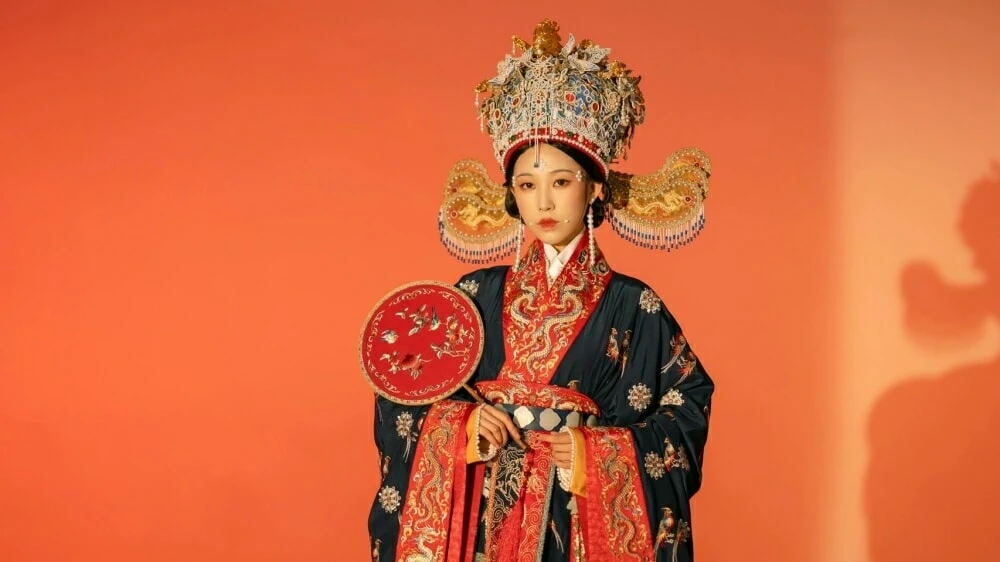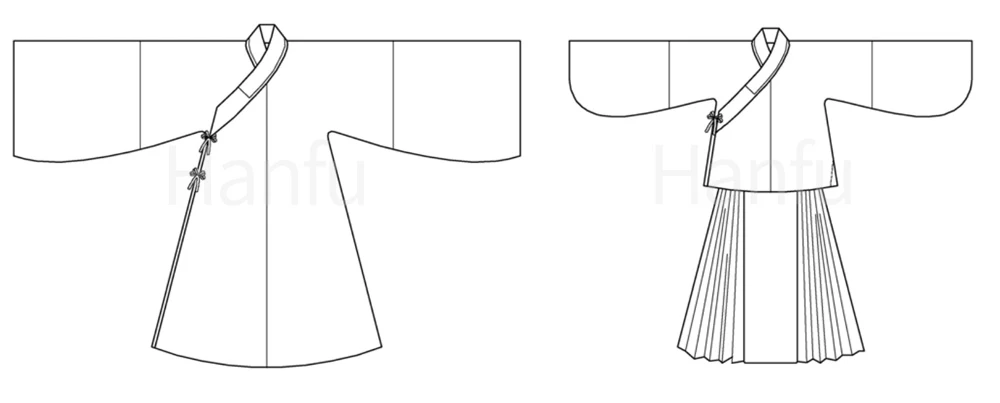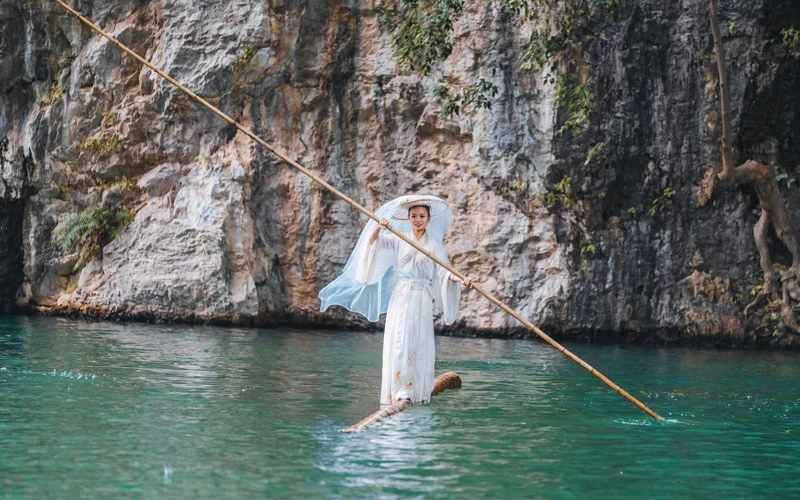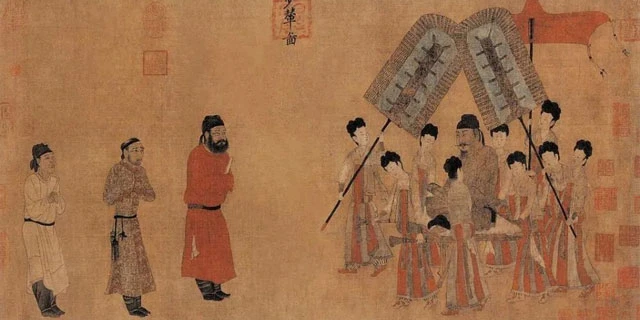Must See
Everything About Hanfu - You Will Be Interested In

Fashion
Find the latest China's fashion, Hanfu, Han element, cheongsam qipao and other Chinese retro and fashion clothing.
-
Did the ancients not worry about things falling out of their sleeves? In the historical drama Lotus Tower, the character Li Lianhua is nicknamed 'Lotus Pockets' by netizens. His role is like Doraemon, pulling out items such as secret letters, tokens, rings, water bottles, swords, and small objects from his sleeves. Could ancient people really stuff so many items of different sizes into their sleeves? Li Lianhua's sleeves seem incredibly capacious! Here's the conclusion: most sleeves that could hold items had cuffs. Unlike the wide - open sleeves used for ceremonial purposes, which generally couldn't hold things directly, and attendants often carried bags for them. Besides sleeves, ancient people also used handbags and backpacks. So, when you see characters easily taking out porcelain bottles or silver from their sleeves or belts, you might wonder—doesn't it hurt? More importantly, wouldn't things fall out? Sleeves with cuffs generally had two features: some were naturally gathered, like pipa sleeves or chuihu sleeves, forming a pouch - like shape. Others had hidden stitching inside wide sleeves to prevent slipping and hold lightweight items. However, carrying heavy or large items in sleeves would be noticeable. So, ancient people often carried small bags, either hidden in…
-
Recently, stills of Guli Nazha wearing Hanfu were released. Netizens noticed the trendy collar - turning style. Did the Chinese in the Ming Dynasty already have polo shirts? Let's start with the conclusion. It's an adjusted way of wearing a standing collar. Some previously criticized Ming - style Hanfu for not showing the neck well and making the face look bigger. This collar - turning method is a great solution. It offers more styling options and allows better ventilation in summer by unbuttoning the collar, killing two birds with one stone. The Ming Dynasty was a period when 'polo - shirt - style' clothing was very popular. A short - sleeved standing - collar diagonal - closure shirt was unearthed from a Ming tomb. The small white folded collars in ancient paintings might be the effect of wearing such short garments underneath. I initially speculate this short garment meets key criteria for innerwear: it's plain or light - colored, versatile for pairing with outerwear; it uses ties instead of buttons, not interfering with the outer layer. Recall our previous explanation about the Tang Dynasty's round - collar robes. Their innerwear was often half - sleeved. This shows why innerwear often…
-
In the historical drama 'Si Jin,' Jing Tian's wedding headdress has sparked an online debate. Many criticized it for resembling a Qing Dynasty 'qitou.' But is it really a Song Dynasty costume paired with a qitou? The answer is no. This headdress actually comes from the Song Dynasty's 'Chuijian Guan' (Drooping Shoulder Crown), a trendy accessory during the mid - to - late Northern Song period. As recorded in 'Chen Shi,' '...the longer corners droop down to the shoulders, hence called Chuijian.' Similar crowns were known as 'Dengjian' or 'Duojian,' with widths reaching up to two or three chi. People had to turn their heads sideways to enter a carriage because of the crown's width. The character 'Duo' means 'drooping.' Based on the round crown design, this accessory got its name as its sides drooped and were often adorned with gold, silver, pearls, or jade. For instance, Wang Churan's look in 'Serenade of Peaceful Joy' referenced this crown, which reflected her bold personality in the early part of the story. This crown was extremely popular at that time, imitated by people from the imperial court to commoners. 'Dream Pool Essays' described the attire of Li Shishi, a courtesan favored by…

Wear Hanfu
About different styles of hanfu wear recommended: traditional hanfu, modern hanfu, hanfu inspired, hanfu accessories, etc. Also includes tips on how to wear hanfu during seasons and traditional festivals.
-
One of the joys of wearing hanfu is discovering how effortlessly it can be adapted to different lifestyles, beliefs, and personal preferences. As a hijabi, one of my biggest considerations when choosing clothing is modesty. Thankfully, many hanfu styles already cater to this ideal with their long, flowing silhouettes, layered structures, and elegant designs. In fact, I’ve found hanfu to be one of the easiest traditional outfits to wear while staying true to both my modesty and aesthetic preferences. Although some hanfu styles are more fitted around the waist or involve shorter sleeves or lower necklines, there are many that work beautifully for hijabis without needing any extra modifications. Personally, I’m especially drawn to Ming dynasty style hanfu. These often feature a mamianqun skirt paired with either a shorter shirt (duijin shan) or a longer robe-style shirt (aoqun or dachang), both of which are generously cut and non-revealing. The fabrics drape naturally, the overall silhouette is loose, and the layering makes it feel effortlessly modest. The added bonus? Mamianqun prints are just stunning. The way the pleats open and close as you walk, revealing flashes of the pattern, creates a sense of movement and beauty that makes me feel elegant…
-
In recent years, there’s been a surge of interest in hanfu, not just as traditional attire, but as something that can be part of everyday life—including the workplace. For women who love hanfu and want to express that part of their identity in professional settings, there are more options now than ever before. With both modernised and traditional hanfu being widely available online, it’s becoming increasingly realistic to integrate this historical clothing into our weekday wardrobes. Modern hanfu—sometimes referred to as “fashion hanfu”—has already been adapted for casual social use. According to NewHanfu, it “inherits the elements of traditional Hanfu, and through long-term innovation and development, it is well adapted to the convenient social life in today's modern times.” This means pieces are typically more streamlined, accessible, and comfortable, often made with materials and cuts that suit daily wear. As a result, many modern hanfu outfits can already pass for smart-casual in a workplace setting. Pairing these with accessories like a structured purse, a watch, or a blazer can easily help elevate the outfit to look more professional without compromising the hanfu aesthetic. That said, I personally think there’s also space for more traditional hanfu elements in the workplace—if styled…
-
There’s a certain kind of outfit that turns heads, not just because it’s beautiful, but because it leaves people wondering: Is this really how ancient people dressed? Enter the Qixiong Ruqun (齐胸襦裙), a style of Hanfu where the skirt is tied all the way up to the chest—sometimes even under the armpits. It’s dramatic. It’s feminine. And it’s sparked years of debate over whether it’s based on history or pure fantasy. The Rise of a Silhouette That Defies Gravity At a glance, the Qixiong Ruqun feels like a distant cousin of the Korean Chima Jeogori—a wide-skirted dress worn high on the torso, paired with a short jacket. In fact, when you fluff out the skirt and widen the waistband, the two styles can look eerily similar. But the rabbit hole runs deeper than visual resemblance. Questions around the Qixiong Ruqun don’t just come down to aesthetics. They ask something more fundamental: How do you even keep this thing from sliding down? Anyone who’s tried wearing one has likely felt that awkward sensation—the pull of gravity on a waistband that doesn’t seem to be anchored to anything solid. It’s not a minor wardrobe inconvenience. It’s a design flaw. And it’s raised…

Hanfu Making
About Hanfu making, including cutting & sewing patterns for different Hanfu styles.
-
To create a traditional horse-face skirt is to converse with centuries of artisans. This process, honed during the Ming Dynasty and refined in the Qing era, transforms raw fabric into a cultural statement. Far from a simple garment, each skirt embodies calculated geometry, symbolic motifs, and generational wisdom—a wearable archive of Chinese craftsmanship. Material Selection Traditional skirts begin with fabric choices steeped in regional logic. Ming artisans preferred luo silk, a lightweight yet durable weave that allowed pleats to hold their shape without stiffness—ideal for Jiangnan’s humid climate. Qing tailors often opted for kesi tapestry silk for outer panels, its slit-tapestry technique enabling photorealistic embroidery. Modern recreations face ethical dilemmas: while purists source wild mulberry silk from historic Zhejiang farms, eco-conscious brands like Vermillion Phoenix now use organic hemp dyed with tea leaves to mimic antique hues. Pattern Drafting: Geometry in Service of Grace The four-panel template follows strict proportional rules. A typical Ming skirt for a woman of 165cm height requires: Two outer panels: 50cm wide x 105cm long Two inner panels: 30cm wide x 105cm long Waistband: 8cm wide x 110cm (allowing overlap) Historic pattern books like the Yuanyang Pu (1627) reveal secret adjustments: a 3° outward flare on outer panels to enhance the “horse face”…
-
Why should hanfu makers turn to thrift stores? For the deals, of course!
-
Peony Perfume Persists: The New Frontier of Scented Garments In the heart of China's Shandong province, a quiet revolution is taking place. The ancient city of Heze (菏泽), long renowned for its peonies, is now at the forefront of a technological breakthrough that's set to redefine the intersection of tradition and innovation in the world of fashion. At a recent women's handicraft exhibition, all eyes were drawn to an extraordinary display from Cao County, Heze. The star of the show? A skirt that seemed to bridge centuries, combining the timeless elegance of traditional Chinese hanfu with cutting-edge textile technology. This wasn't just any skirt - it was a garment woven from peony fibers, infused with a fragrance that could last for two years. Yao Chihang, the visionary behind the "Luo Ruyan" hanfu brand, beamed with pride as she explained the intricate process behind this marvel. "We've developed a new technique to extract fibers from peonies," she revealed. "During the weaving process, we embed the peony fragrance into the fabric itself, ensuring the scent remains for at least two years." This innovation isn't just a novelty; it's a testament to the potential of merging ancient craftsmanship with modern technology. The skirt itself…
-
Last Friday 3/17 I was invited to a local Chinese school to give a small talk on hanfu! The aim was to share hanfu culture with more people here and to present an example to the kids of what doors can be opened to you by maintaining language skills. A little background—I myself attended this once-a-week school from kindergarten up until 6th grade, upon which I pulled out of the school to invite the Chinese teacher that taught me in 6th grade to tutor me at home privately. She was a great tutor and a key part of inspiring my interest in ancient Chinese culture through poetry, history, and more, keeping me engaged while analyzing Tang Dynasty shi and Song Dynasty ci. As I got busy, I stopped the tutoring when I was in 10th grade—and I was introduced to the concept of hanfu not even a few months later! I’ve kept up communication with this teacher for a while (whose name I won’t disclose for privacy reasons) and visited her in Taiwan throughout the years. This year she came back to teach at the local chinese school and invited me to give a talk on hanfu there. For the…
-
I made my first real Hanfu based on patterns from this website. First outing at the beach, with dragons and all. Here is an article with much details on my sewing journey.
-
Wearing armor, riding a horse, holding a traditional weapon, fighting on the battlefield. Such a scene may have appeared in the dreams of many people when they were young. But there is a person who turned the traditional Chinese armor in the dream into reality, he is the first person to restore the ancient armor of the Tang and Song dynasties, Wen Chenhua (温陈华). He has highly restoration the armor of the Song dynasty, which has been lost in China for 700 years, after 6 years. He founded the Lian Kai Tang (炼铠堂), and with his own strength, he promoted the obscure armor restoration craft, and let Chinese armor on the world-class combat stage. #01 The first person in traditional Chinese armor restoration There are only about 1000 armor restorers in China, 90% of them are Wen Chenhua's students, and for 40 years, he has been restoring Jiazhou (甲胄, traditional Chinese armor) to the extreme. On Wen Chenhua's social platforms profile, there is only a simple sentence "Top Chinese Jiazhou maker" as an introduction. However, he has shared a lot of armor design drawings and finished armor photos, all revealing his deep love for Jiazhou. Traditional armor restoration and…
-
In many historical dramas, intricate half-face masks have become a popular accessory. A common question arises: how are these masks secured to the face without slipping? The answer lies in their design. These masks, often referred to as Mianju (面具), are fastened with ties at the back of the head and feature a nasal groove to prevent sliding. While some associate such masks with Western culture, ancient Chinese hollow masks, particularly those from the Shang and Zhou dynasties, showcase remarkable craftsmanship. The Shang-Zhou period produced two primary types of masks: human-faced (Renmian) and beast-faced (Shoumian). The former, like those unearthed at Sanxingdui (三星堆) and Jinsha (金沙), feature exaggerated eyes and ears. The latter blend multiple animal traits into abstract designs. Contrary to popular belief, many ritual masks weren’t worn on faces—their rough, unfinished backs suggest they adorned pillars for ceremonial purposes. However, wooden masks were likely wearable, as hinted by their refined construction. By the Northern Wei dynasty, masks evolved toward openwork designs with sophisticated motifs like Taotie (饕餮) patterns, showcasing a shift from symbolic abstraction to three-dimensional realism. Tang Dynasty masks reached new heights of lifelikeness, as seen in Hufeng (胡风) masks with eye cutouts for wearability. Archaeological finds…
-
If you’ve ever wandered into the comments section of a Chinese historical drama, there’s a good chance you’ve seen someone ranting about whether the actors are wearing their robes “correctly.” And by “correctly,” they often mean one of two things: first, is the hair tied up or left loose? And second, is the robe crossing left-over-right (zuo ren, 左衽) or right-over-left (you ren, 右衽)? This second one—zuo ren—is where things get weirdly intense. What Does “Zuo Ren” Actually Mean? So what’s the big deal with zuo ren? Technically, it refers to the way a garment crosses over the body. If the left side overlaps the right, that’s zuo ren. Right over left? That’s "you ren", which is traditionally considered “correct” in Han Chinese dress. Confucius (孔子) even name-dropped zuo ren in the Analects (论语) , saying that if not for the statesman Guan Zhong (管仲) , “we’d all be wearing our hair down and robes crossed the wrong way”—basically, we’d be living like barbarians. Which sounds dramatic. But here’s the thing: even in Confucius’s time, not everyone outside the Central Plains actually wore zuo ren. For example, the people of Chu (楚国) —a powerful southern state considered “semi-barbaric” at the…
-
It’s funny how we throw around the word “Dunhuang” like it’s a single, well-defined thing. For most people, it’s synonymous with the Mogao Caves—those dusty, majestic Buddhist grottos in the far-flung desert of northwestern China. But Dunhuang (敦煌) is less of a place and more of a time capsule layered with over a thousand years of belief, brushstrokes, and guesswork. It isn’t just one cave, one dynasty, or one style. It's an ecosystem of art, faith, and faded colors—held together by sand and memory. Let’s clear one thing up first: Dunhuang isn’t just the Mogao Caves. It includes the Yulin Caves (榆林窟), the Western Thousand Buddha Caves (西千佛洞), and even more obscure clusters like the Five Temple Caves (五个庙石窟). It's more accurate to call it the Dunhuang Grotto Complex—a network of spiritual and artistic experimentation that unfolded across centuries. Not Just Tang Dynasty Grandeur We love to associate Dunhuang with the Tang Dynasty (唐朝)—maybe because the Tang's cultural glamor fits so neatly with the image of heavenly bodhisattvas strumming pipa mid-air. But that's a postcard version of Dunhuang. In truth, the site saw activity from the 4th to the 14th century, spanning dynasties like the Northern Wei (北魏), Sui (隋),…

